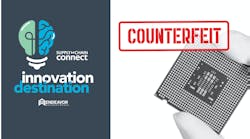Earlier this summer, a man from Massachusetts pleaded guilty to importing counterfeit semiconductors from China for sale in the United States. The offender knowingly sold counterfeit semiconductors to the United States Navy base in Connecticut for use in nuclear submarines. The counterfeit parts distributed to the Navy and military contractors from February 2007 to April 2012 bore the trademarks of legitimate original semiconductor companies.
In his plea deal, the counterfeiter will be sentenced to prison for up to 46 months (less than four years) for the following offenses: conspiring to traffic in counterfeit goods, conspiring to traffic in counterfeit military goods, trafficking in counterfeit goods, conspiring to commit wire fraud, wire fraud, and conspiring to commit money laundering.
A statement from Acting Assistant Attorney General Mythili Raman of the Justice Department’s Criminal Division claims that: “The charges unsealed today demonstrate our steadfast commitment to working with our law enforcement partners to prosecute counterfeiters and others who risk the security of the men and women of the U.S. military.”
“Counterfeit semiconductors pose a serious health and safety risk to consumers and end-users, and an even greater threat to the safety of the men and women of our armed services when they are sold for use in the military,” said Acting U.S. Attorney Deirdre M. Daly. “We will prosecute these types of cases to the fullest extent of the law.”
Less than four years in prison is hardly throwing the book at the offender.
The semiconductor industry and its supply chain partners would benefit from a collaborative effort with the government to develop a more comprehensive and effective anti-counterfeiting technology. The Semiconductor Industry Association (SIA) has already put in, at minimum, five full years of research to bettering the semiconductor supply chain and is willing to work side-by-side with the government to research and develop additional technologies that would offer a more effective solution. The truth is, counterfeiters are becoming more technologically advanced and rehearsed in their practices.
Counterfeit devices are harder to detect by simple visual inspection efforts. The independent channel struggles to determine if a part is new because a vast majority of the independent channel subcontracts true-component testing. In a recent event, the Defense Logistics Agency (DLA) received DNA-marked devices that were in-fact suspect counterfeit, for instance.
Unfortunately, the devices were not properly disposed of (according to the National Defense Authorization Act, these parts should have been held by DLA). Aside from tagging methods, it is critical that government procurement personnel consistently focus their efforts and continue establishing partnerships with fully OCM-authorized sources, whose product is factory-direct, new, and already guaranteed without DNA marking.
In practicing this, situations similar to this recent DLA incident can be avoided. Policies should be adjusted to make authorized sources exempt from the DNA-marking requirements due to contractual obligations that are already set between themselves and the original manufacturer. Currently, the DNA marking at DLA is primarily being used as an internal supply chain tracking mechanism and has very little to do with fighting counterfeit.
One of the more significant issues is the current DLA procurement system for semiconductor devices. This system was born in the early 1980s when DLA was a far bigger percentage of the semiconductor market. This procurement system is effectively a public Internet auction for their business. That approach is reasonable when your market share warrants; but when market share is at 0.2% at best (per latest SIA figures), it is hardly appropriate. It allows DLA to bypass the normal Defense Federal Acquisition Regulation (DFAR) procedures to include companies not fully authorized. In other words, its openness in business practices has allowed the independent distributors and brokers to sell non-authorized products with only traceability and tagging via the mandate. Traceability does not mean authorized, and it does not ensure the quality or reliability that authorized does. This needs to change, especially in matters of our most advanced military equipment, including nuclear submarines in Connecticut.
There is no question that product available in both the fully authorized channel and independent channel should be bought through the authorized channel by DLA. Very credible independent brokers have made this public statement many times.
If the DLA were to develop an authorized vendor list (AVL), in which members of the list were purely authorized sources of the original component manufacturers (OCMs), and send requests for quotes (RFQs) to this list first at the exclusion of the independent channel —where there is a much higher risk of counterfeit—they would know if a product is available through an authorized source. If no reply comes via that channel, DLA would know they had to go through the independent channel. The DLA would also know at this time that all kinds of validation and verification should be happening to the product procured from this channel.
This simple change in procurement would set very clear direction as to what happens to the product. The DLA could mark product procured through the independent channel however it wants. Developing an AVL with authorized sources as a priority is exactly what all the major DoD original equipment manufacturers (OEMs) do today. DLA is the exception and shouldn’t be the rule.
Simultaneously, the DLA needs to work with the semiconductor industry and not mandate solutions. The DLA should be addressing its out-of-date procurement system for semiconductors. No DoD system OEM procures semiconductor components without an AVL and posts “opportunities” on the web hoping for a response.
In addition to doing independent research on semiconductor anti-counterfeit measures, the DLA should also use SIA member experts in co-evaluation and co-determination of what makes sense for the parts that DLA will procure. DLA has never provided forecast data for products—a practice unheard of in the DoD OEM world. If DLA were to work with the semiconductor industry on at least an unbinding forecast of products, this would be a step in the right direction. This would give the highest odds of a solution bought into by industry, lowest cost, and realistically implementable for DLA. The end-result of these solutions is a common-sense approach to procurement, at a significantly less cost, with more fully authorized parts available with warranty, and semiconductor industry buy-in. Most importantly, these solutions give the highest quality product to our nuclear submarines and other military equipment.









